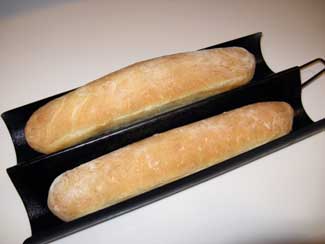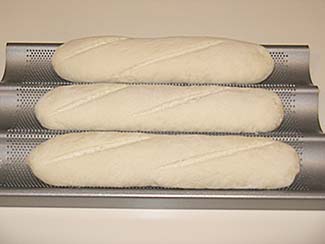French Bread
This recipe was adapted from The Art of Food Processor Cooking by Jane Salzfass Freiman.
The dual secrets to making French bread are the flour and the bread pan. You can't get real French bread flour in the U.S. (or at least I can't) but it is possible to come close by mixing a little cornstarch into bread flour. (Freiman uses a mixture of cake flour and bread flour for the same purpose.) French bread made with unbleached all-purpose flour has a different texture from that made with bread flour, but both are good.
The other half of the secret is in the bread pan. What is required is a long black steel loaf pan that looks like a piece of stove pipe split along its length and folded open. I've also had good results with a Chicago Metallic three-loaf baguette pan, as shown below. You can bake French bread on a flat sheet or stone, but the loaf will be wider and thinner, and the texture will be different.
The recipe below assumes a food processor, but can be done by hand. Beware that the entire process takes three to six hours or more, so start early.
Step One: Make the Starter
2/3 cup warm water
1-1/2 tsp active dry yeast (Read my thoughts on yeast)
1 tsp sugar
3/4 cup bread flour or unbleached all-purpose flour
Dissolve the sugar and yeast In the water in a medium bowl. Add the flour and beat it in with a fork. The mixture will be lumpy. Cover the bowl with plastic wrap and put it in a warm place until the starter is bubbly and about doubled in bulk. (A gas oven with only the pilot light on is an excellent place for this, and for allowing the dough and loaves to rise as well. An electric oven preheated to its lowest temperature for two minutes, then turned off, works, too.) Rising time for the starter is 1-1/2 to 2 hours.
Step Two: Make the Dough
2-1/4 cups all-purpose flour
2 or 3 tablespoons cornstarch
1-1/2 tsp salt (Kosher or non-iodized)
2/3 cup warm water
starter mixture (above)
Put the flour, cornstarch, and salt in the bowl of the food processor with the metal knife blade and sift together with two or three five-second pulses. Do not omit the salt. The more cornstarch you use, the lighter the bread will be (up to about four or five tablespoons).
Scrape and pour the starter mixture into the food processor and pulse a few times to mix it with the flour. With the processor running, add about 2/3 of the water. Wait ten seconds, then add more water, about a tablespoon at a time, until the dough forms a ball that cleans the sides of the food processor bowl. Add another two tablespoons or so of water and process for 30 seconds to knead the dough.
Rinse a large bowl with warm water and drain it but do not dry it. Scrape the dough into the bowl, cover with plastic wrap, and let rise as described above until tripled in bulk. This takes 2 hours or so.
Step Three: Form the Loaves 
If using a black steel pan, pour a little cooking oil on a paper towel and lightly oil the baking pan. (Or squirt with Pam.) Omit the oil if using a non-stick pan. Set aside.
Punch the dough down and turn it out onto a floured surface. With a sharp knife cut it into two equal pieces, three if using a three-loaf pan. Set one aside. With floured hands push and pat one of the pieces until it is a rectangle about five inches wide and almost as long a the pan. Brush excess flour off the top with a pastry brush, fold in the oblong ends and fold in half. Push the folded piece until it's about five inches wide, brush and fold again. Repeat a third time unless the dough is becoming difficult to work with.
After the last fold, don't flatten or widen the dough. Just brush it off, then bring the two (long) edges up toward the middle and pinch them together all along the length to form a cylinder. Tuck in any excess on the ends and pinch them closed. Roll it back and forth on the work surface a few times to make a cylinder. Transfer the loaf to the pan, seam side down. Form the next loaf the same way. Cover the loaves with a dry towel. (In very dry weather, cover the dry towel with a damp towel) and set aside to rise until doubled in bulk, about n hour. Be careful not to let the dough over-rise.
Step Four: Prepare for Baking and Bake
Preheat oven to 550° F. (Yes, 550 degrees!)
(optional) one egg white, beaten with 1 tsp water
If you decide to use an egg glaze, brush the loaves carefully with the egg glaze and allow the glaze to dry, about 15 minutes.
(Optional) Cut two or three diagonal slashes along the top of each loaf with a very sharp knife or a razor blade. If your knife isn't sharp enough, you'll deflate the dough. (I use a surgical scalpel for this!)
Put the loaves in the oven and reduce heat to 450°. Your 550° oven will fall to 500° the moment you open the door to put the bread in. Having a very hot oven to start will help the "oven spring," the phenomenon of the loaves rising further as they're heated by the oven. (The oven spring stops as soon as the outer crust solidifies.)
Bake at 450° until done, 25-30 minutes. Spray the inside of the oven with water from a plant mister (2 or 3 sprays) when you put the bread in, and again after about 15 minutes. (The steam makes a crisp crust.) Cool on a rack before serving.
Last updated:
2024-10-22 17:10
Orignially posted: 2009-09-12
All comments are moderated. Uncivil comments and comments not relevant to this topic will be discarded.
comments powered by Disqus
